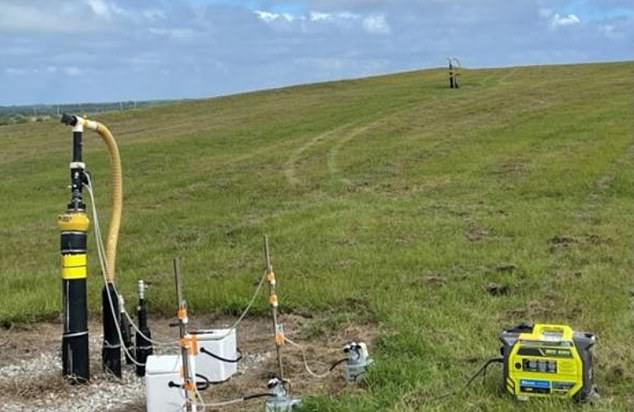Scientists discover that garbage and waste piles ‘burp’ high levels of cancer-causing chemicals that pollute the air we breathe
Landfills across the US “belch” toxic gases into the air as waste decomposes, releasing a stream of forever airborne chemicals into the atmosphere and poisoning the air we breathe.
Forever chemicals, so named because they can survive in the environment and the human body for months or even years, are known to increase the risk of thyroid, kidney and testicular cancer, heart disease and liver damage.
The chemicals, known as PFAS, are ubiquitous. They have penetrated water and food supplies. They coat food containers, nonstick cookware and water-repellent clothing, make firefighting foam and make certain clothing stain-resistant.
Researchers tested the air around three Florida landfills filled with PFAS-laden decomposing food, clothing, cosmetics and sewage sludge.
They found that 13 different types of forever chemicals were circulating in the emitted gas, polluting the surrounding air and potentially harming anyone who breathed it, even from miles away.
Researchers from Yale University and the University of Florida already knew that water flows through waste material in a landfill and leaches into groundwater and surface water sources. This is known as leachate.
They wanted to understand how this PFAS-laden water spill compares to the composition and mobility of PFAS in the toxic gases emitted from landfills. Once PFAS becomes airborne, it can spread widely, even across continents.
Researchers have been trying to determine which pathway – leachate or landfill gas – contributes most to PFAS emissions from landfills.
They went to three different locations in Florida and installed air pumps to extract gas.
The pump contained a cartridge filled with resin that captures substances floating in the air. They then took those cartridges to the laboratory to isolate the compounds trapped in the resin.
Burped gas is mostly methane and carbon dioxide, but these scientists also discovered that the gas was full of chemicals.
Most of the PFAS they found belonged to a class of compounds called fluorotelomer alcohols. Like other PFAS compounds, fluorotelomer alcohols have high fluorine content, which means they can remain in the environment for months or years.
The concentration of fluorine in landfill gas ranged from 32 to 76 percent of the total mass of PFAS, compared to 24 to 68 percent in landfill leachate.
Even under conservative assumptions, the mass of PFAS leaving via landfill gas was comparable to or greater than that of leachate.

Researchers installed air pumps at landfills to capture PFAS-laden gas
According to the researchers, “These findings suggest that landfill gas, a less-explored byproduct, represents an important route for the movement of PFAS from landfills.”
Landfill leachate, the liquid that flows from landfills, is typically collected and treated to prevent further contamination into the environment. However, landfill gas, including methane and PFAS, is released into the atmosphere untreated and uncontrolled.
The study suggests that while pollution reduction efforts typically focus on PFAS in drinking water supplies, the gas released from these mass storage sites should be included in future plans to reduce exposure to the chemicals.
Some landfills burn these gases or capture them for energy, but researchers say these methods may not be effective at removing airborne pollutants.
PFAS pose a laundry list of health risks, ranging from cancer to organ damage. The chemicals settle in body tissues where they can survive for more than seven years without breaking down.
In 2023, doctors at Mount Sinai Hospital in New York tested blood samples from people with and without thyroid cancer and found that patients with the disease were 56 percent more likely to have levels of PFAS chemicals in their systems.
PFAS also cause inflammation in the body, leading to DNA damage in thyroid cells. This can result in genetic mutations that stimulate the production of cancer cells.
Meanwhile, researchers from the University of California San Francisco, University of Southern California and University of Michigan showed that women with higher exposure to PFAS were twice as likely to report a previous melanoma diagnosis than women in the lowest exposure group. the chemicals.
The study also found a link between PFAS and a previous diagnosis of uterine cancer, and women with higher exposure also had a marginal increase in the risk of previous ovarian cancer.
And PFAS can wreak havoc on the body’s balance of hormones that regulate fertility and reproduction.
American and Singaporean researchers reported last year that women with different types of PFAS in their blood who tried to conceive were up to 40 percent less likely to become pregnant and give birth to a live child.
The results of the experiment have been published in the journal Environmental Science and Technology Letters.
